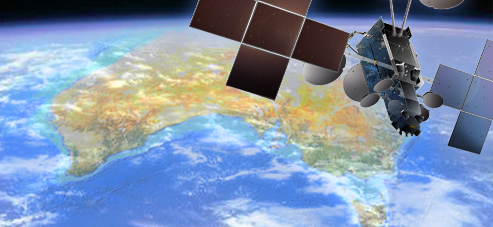- First NBN-connected cafe opens
- Problems and solutions with satellite technology
- Gillard announces new satellite network to complement NBN
As a long term project bogged down in bureaucracy and political arguments, it's difficult to provide any sort of fixed timeline for NBN updates. For many weeks of the year, the NBN is all but invisible, with the only sign of its existence the technicians quietly laying out line after line in an effort to connect the country.
Other weeks, however, we can see big things happening, not just in the political sphere – it's impossible to keep track, at this point, of who in the Liberal Party supports the NBN this week, and who can't wait to be in power so that they can rip up the optic fibre and dance on it in the streets. It's a good week when we can report about the actual infrastructure and policy going on behind the NBN, and this week there are two important things to point out.

The NBN takes to the skies!
The first NBN-connected café has opened in Brunswick. Hungry Birds, a Brunswick café that shares a building with eight other small businesses connected to the NBN, has opened up its free WiFi to customers – and the free WiFi this time is an NBN connection.
An NBN connection this publicly accessible is sure to attract attention, and the café had its fair share of visitors over the last few days, from Stephen Conroy to tech bloggers keen to try out the speeds. (One tech blogger from Lifehacker tested the NBN connection against Telstra's 4G speeds, and found a significant difference – download speeds on the NBN connection were at 13.39Mbps, vs. 4G's mere 6.08Mbps. A nice little putdown for those still railing about 4G's superiority.)
MP for Willis Kelvin Thomson said: "Café culture is an essential part of Brunswick life. Melbournians love nothing better than getting together, eating food, drinking coffee, and increasingly getting online. The speed and reliability of the NBN complements this culture so well."
Whether or not we can truly sell the slogan "NBN connections: taste even better with coffee!", it's an encouraging sign to see an NBN connection out in the wild like this in such a mundane and natural part of life. We hope to see many similar cafés as the NBN spreads across Australia, hopefully ones that news outlets will have a harder time connecting to popular apps. (Think about it a moment. We can't make all the puns for you.)
In addition to that, the Prime Minister has announced an extension of the NBN's satellite provisioning, drawing attention to a $280 million plan for the construction of new satellite antennas, 20,000 satellite dishes, and the network infrastructure to back it up.
The satellite network isn't going to be quite as impressive as the NBN itself will be, topping out at only 12Mbps (compared to the NMB's guaranteed 100Mbps or even 1GBps speeds that many are holding out for). However, considering that many customers who are currently on satellite are experiencing dial-up like speeds, this is a huge step forward; 12Mbps may not be lightening fast, but it is a more than adequate connection that should be able to handle most types of internet usage – streaming video or video chats may lag a little, but certainly it will be a huge improvement on current satellite technology.
Particularly this network is important because a satellite connection is often one of the worst types of connection available in Australia, with slow, unreliable speeds and frequent drop-outs. Satellite broadband uses Low-Earth-Orbit (LOE) satellites to connect to the internet, and as a result the technology is both difficult to set up (in terms of how much it costs) and difficult to connect to (in terms of how it works). What you end up with is one of the most inefficient and most expensive ways of creating a broadband connection.
Despite this hassle, the second unfortunate thing about satellite plans is that usually, if you're on a satellite broadband connection it's because you don't have any other options in your area. People don't sign up for satellite broadband in the same way they do for ADSL2+ or even mobile broadband (an option which is also very flawed as an internet connection that you're dependent upon), and what that means is that satellite broadband is usually considered a last resort. If a person's on satellite, that means that it's very unlikely they're going to be able to find any other alternative to provide them with better internet access.
This is part of what makes the NBN so important, in being able to provide fixed line fibre connections to 97% of Australian homes. For the other 3% we've been promised very fast mobile broadband networks, but the option to have a new and improved satellite network is a great thing to have on the horizon as well. One of the great benefits of the NBN is opening up options, both for more competition in the market and more choice for customers who until now have had no choice whatsoever.
The new satellite network is going to play a big part of that role in expanding Australian options and horizons, particularly in rural and regional areas. As well as that, while getting the satellite system operational will still be a lengthy process, it will be faster than the NBN itself, coming out within the next three years, rather than the next ten.
The new satellite network is scheduled to be operational in 2015. We await it eagerly!
NBN-based connections are not yet widely available. For those who want to take advantage of great value plans with short or no contracts, we recommend:
TPG’s Unlimited $60 ADSL2+ Bundle (6 month contract) – Call 1300 106 571;
iPrimus can offer Naked DSL connections, with unlimited data, from just $69.95 a month - available on 0, 12 and 24 month contract terms. Call 1300 137 794;
Internode has a 200GB Easy Bundle for $80 with no contract, call on 1300 106 571.
Want to know when the NBN is coming to your area? Give us a call on 1300 106 571 and we can talk about that with you, along with what your options are before the NBN gets there.


